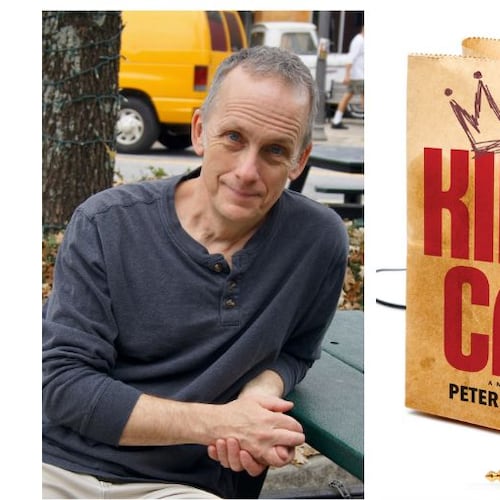While plucking the 20 most momentous Billboard No. 1 hits over six-plus decades, music critic Tom Breihan skipped over no shortage of notable Georgia artists, from Gladys Knight and Ray Charles, to R.E.M. and OutKast.
The ones that made the cut in his new book “The Number Ones”? Atlanta’s Soulja Boy, the man behind the 2007 surprise hit “Crank That (Soulja Boy),” and hip-hop duo Rae Sremmurd with 2016′s “Black Beatles.”
So while the the book does explore some of the biggest names in pop history such as the Beach Boys, Fleetwood Mac, Mariah Carey and BTS, it tackles lesser lights such as Chubby Checker, George McCrae and Vanilla Ice.
Credit: Andrew Shurtleff Photography, LL
Credit: Andrew Shurtleff Photography, LL
“The book is about points of rupture,” Breihan explained in an interview with The Atlanta Journal-Constitution.
Some of these “rupture” points are super obvious but necessary to cover. There are chapters on the Beatles via “I Want to Hold Your Hand” in 1964, the mesmerizing power of Michael Jackson via “Billie Jean” in 1984 and teen pop idol Britney Spears with her breakout 1998 hit “...Baby One More Time.”
But Chubby Checker created a massive dance craze with “The Twist,” which hit the top of the charts in 1960, then again in 1962. George McRae’s “Rock Your Baby” tapped into early disco in 1974. And Vanilla Ice’s oft-reviled “Ice Ice Baby” was, for better or worse, the first rap song to hit No. 1 in 1990.
And Breihan explains why Soulja Boy (real name: DeAndre Way) made the cut for “Crank That” in 2007. He was the first artist to use the Internet to work outside the record label system and generate a No. 1 song at the tender age of 15.
“Soulja Boy is the original self promoter,” Breihan said. He created his songs using a demo version of a digital audio workstation FruityLoops (now FL Studio) from his house and posted them on SoundClick, an early social-media platform. He then linked and cross-promoted on multiple mediums.
As Breihan wrote, “He might have been only a serviceable musician, but he was a genius-level early adopter.” He wrote his own Wikipedia entry. He’d mislabel his songs on Limewire, an illegal music-download site, so more folks would hear his music. He created a dance instruction video on a new site called YouTube for “Crank That,” which went viral. Interscope signed him. He sold millions of ringtones, which were briefly popular, and iTunes downloads.
Breihan said Soulja Boy’s impact resonates to this day, his strategies refined by the likes of Drake, Nicki Minaj, Justin Bieber and fellow Atlantan Lil Nas X.
In fact, Breihan did consider placing Lil Nas X in the book with his country/rap song “Old Town Road,” which broke the record for longest No. 1 single in history at 19 weeks.
Lil Nas X created a clever strategy to maintain interest in his song by releasing multiple remixes of it to fuel interest, including a version with Billy Ray Cyrus. For more than four months, he was able to keep his streaming numbers ahead of everyone else, including Billie Eilish, who tried the same strategy by adding Bieber to “Bad Guy” to try to knock Lil Nas X off the top. It eventually worked.
TikTok, which was new in 2019, also helped fuel the song’s success.
“At the time I was writing the book, I didn’t fully realize how important TikTok would become,” Breihan said. “It’s where hit songs are made now, not just a mutation of MySpace.”
The next chapter focused on Rae Sremmurd, who grew up in Mississippi but made their mark in Atlanta. Their trap song “Black Beatles,” he argued in the book, “represented a big change in the way people consumed, encountered and understood pop music and it also heralded the arrival of a newly dominant genre of pop.”
Credit: John Salangsang/Invision/AP
Credit: John Salangsang/Invision/AP
Indeed, at the time “Black Beatles” was coming out, streaming was rapidly taking over as the primary way people consumed music. And when people briefly jumped on the Mannequin Challenge, when everyone freezes for several seconds while a camera passes by, “Black Beatles” was the primary soundtrack song to the challenge. The song was soon No. 1 for seven weeks.
“I have three straight chapters basically about Atlanta rap,” said Breihan, including another chapter focused on T-Pain, the Auto-Tune king who isn’t from Atlanta but whose sound was deeply influenced by Atlanta. (T-Pain now lives in Atlanta.)
In fact, Atlanta’s trap music has dominated pop music in recent years and so did efforts to create hits using viral memes, with Breihan citing No. 1 songs by Cardi B, Kendrick Lamar, Post Malone and Atlanta acts Migos and DaBaby.
“The Number Ones” is the culmination of a passing idea Breihan came up with in early 2018 while working as a reporter at Stereogum: write stories about every single No. 1 song on the Billboard Hot 100 starting with Ricky Nelson’s “Poor Little Fool” in 1958. He was inspired by a similar column focused on the British charts by a man named Tom Ewing.
Compared to his often opinionated, freewheeling essays in Stereogum with a shorthand 1 to 10 ranking for each song, Breihan took a more measured approach with his book.
“I wanted it to be more reserved and a little bit more respectful,” he said. “The book shouldn’t be about me.”
Still, “The Number Ones” remains a breezy read, packed with interesting facts and historical context.
He also found creative ways to weave into the narratives stories about acts that never made it to No. 1, including Bob Dylan, Bruce Springsteen and the Backstreet Boys.
For instance, in 1984, when Prince’s ‘When Doves Cry” was dominant, it kept Springsteen’s “Dancing in the Dark” stuck at No. 2 for multiple weeks. But Springsteen apparently wasn’t upset and even joined Prince on stage at a concert in 1985. “These guys hit their cultural musical peak at the exact same time and were tipping their caps at each other,” he said.
Georgia’s James Brown is another act that never hit the top of the chart, which surprised Breihan.
“He is one of the most important musicians in the 20th century,” he said, noting that as a consolation, at least 10 No. 1 songs sample from Brown songs.
As for his book, with only 20 slots, he said he is a little bummed he was unable to include songs by Madonna and Whitney Houston. Prince and Mariah Carey ended up carrying the torch for that era.
Currently, Breihan is still pumping out his No. 1 column, about three times a week. He is just past 900 songs and well into 2004. He has nearly 300 more songs to go so he has more than two years before he catches up to the present day.
No. 1 songs nowadays, he said, come largely in two varieties: the fan armies pumping a Taylor Swift or BTS song to the top or some TikTok artist rising from obscurity. “Nobody saw Steve Lacy coming,” he said. “I love the things that can’t be planned.”
About the Author
Keep Reading
The Latest
Featured






